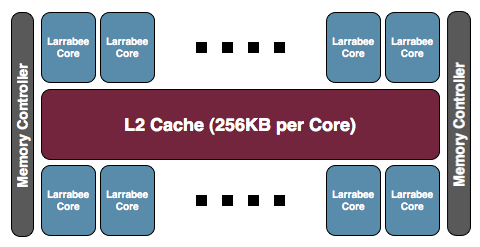Intel's Larrabee Architecture Disclosure: A Calculated First Move
by Anand Lal Shimpi & Derek Wilson on August 4, 2008 12:00 AM EST- Posted in
- GPUs
Putting it all Together - Return of the Ring Bus
Intel is keeping two important details of Larrabee very quiet: the details of the instruction set and the configuration of the finished product. Remember that Larrabee won't ship until sometime in 2009 or 2010, the first chips aren't even back from the fab yet, so not wanting to discuss how many cores Intel will be able to fit on a single Larrabee GPU makes sense.
The final product will be some assembly of a multiple of 8 Larrabee cores, we originally expected to see something in the 24-to-32 core range but that largely depends on targeted die size as we'll soon explain:

Intel's own block diagrams indicated two memory controller partitions, but it's unclear whether or not we should read into this. AMD and NVIDIA both use 64-bit memory controllers and simply group multiples of them on a single chip. Given that Intel's Larrabee will be more memory bandwidth efficient than what AMD and NVIDIA have put out, it's quite possible that Larrabee could have a 128-bit memory interface, although we do believe that'd be a very conservative move (we'd expect a 256-bit interface). Coupled with GDDR5 (which should be both cheaper and highy available by the Larrabee timeframe) however, anything is possible.
All of the cores are connected via a bi-directional ring bus (512-bits in each direction), presumably running at core speed. Given that Larrabee is expected to run at 2GHz+, this is going to be one very high-bandwidth bus. This is half the bit-width of AMD's R600/RV670 ring bus, but the higher speed should more than make up the difference.
AMD recently abandoned their ring bus memory architecture citing a savings in die area and a lack of need for such a robust solution as the reason. A ring bus, as memory busses go, is fairly straight forward and less complex than other options. The disadvantage is that it is a lot of wires and it delivers high bandwidth to all the clients on the bus whether they need it or not. Of course, if all your memory clients need or can easily use high bandwidth then that's a win for the ring bus.
Intel may have a better use for going with the ring bus than AMD: cache coherency and inter-core communication. Partitioning the L2 and using the ring bus to maintain coherency and facilitate communication could make good use of this massive amount of data moving power. While Cell also allows for internal communication, Intel's solution of providing direct access to low latency, coherent L1 and L2 partitions while enabling massive bandwidth behind the L2 cache could result in a much faster and easier to program architecture when data sharing is required.










101 Comments
View All Comments
ocyl - Monday, August 4, 2008 - link
Larrabee will be shipped when Diablo III is, and it will mark the beginning of the end for DirectX.Calling it first here at AnandTech.
Thanks go to Anand and Derek for the very well written article. You are the ones who keep tech journalism alive.
erikespo - Monday, August 4, 2008 - link
"At 143 mm^2, Intel could fit 10 Larrabee-like cores so let's double that. Now we're at 286mm^2 (still smaller than GT200 and about the size of AMD's RV770) and 20-cores. Double that once more and we've got 40-cores and have a 572mm^2 die, virtually the same size as NVIDIA's GT200 but on a 65nm process. "this math is way off
143 mm^2 is 20449mm.. if they fit 10 there that is 2044.9 per core
286mm^2 is 81796mm.. that is 4X the space so 40 cores in 286^2
and 572mm^2 is 327184mm is 160 cores..
double length will double area.. doubling length and width will quadruple area.
bauerbrazil - Monday, August 4, 2008 - link
Hahahaha, YOUR math is way off!!!Jesus.
erikespo - Monday, August 4, 2008 - link
I see where the article and you got your math..you both did 143mm^2 / 10 and got 14.3 then divided 286^2 by 14.3 and got 20.. this math is only acting on the one number..
I know this because the area of 14.3 is 204.49 mm. 10 of those would be 2044.9mm. but the area of 143mm^2 is 20449mm.
WeaselITB - Monday, August 4, 2008 - link
Wow ... No.143mm^2 is NOT equivalent to 143^2 mm ... Your analysis is flawed.
If we use your example, 2mm^2 is NOT 2mm x 2mm ... it's actually root(2)mm x root(2)mm ... 4mm^2 is 2mm x 2mm, not 4mm x 4mm (that'd be 16mm).
Maybe you should examine in depth that Wikipedia article you linked earlier ...
Thanks,
-Weasel
MamiyaOtaru - Monday, August 4, 2008 - link
143mm^2 is NOT equivalent to 143^2 mm^^THIS
That's it in a nutshell. mm² doesn't mean you square 143, it refers to Square Millimeters, a unit of area (unlike Millimeters, a unit of distance).
Revised mspaint illustration: http://img379.imageshack.us/my.php?image=squaremmh...">http://img379.imageshack.us/my.php?image=squaremmh...
erikespo - Monday, August 4, 2008 - link
Anandtech Comment Section.. Forever record of my retardednesserikespo - Monday, August 4, 2008 - link
Dang.. Many apologies..got my square area and squared numbers confused..
WeaselITB - Monday, August 4, 2008 - link
[quote]4mm^2 is 2mm x 2mm, not 4mm x 4mm (that'd be 16mm).[/quote]Dang, that was supposed to read "(that'd be 16mm^2)."
Thanks,
-Weasel
erikespo - Monday, August 4, 2008 - link
another way to look as it is how man 143mm^2 squares does it take to make up 286mm^2?only 2 would only be 143mm x 286mm
since 10 cores fit into 143 x 143, 20 will fit into 143 x 286mm
286 x 286 (which is double that of 143 x 286mm) the 286mm^2 would fit 40